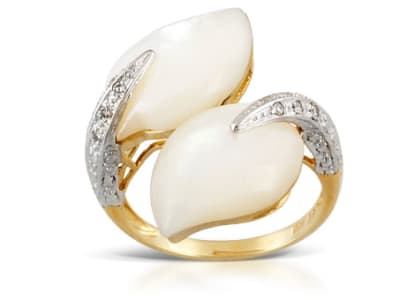Mother-Of-Pearl is the iridescent nacre layer that forms on the inside of a shell. Mother-Of-Pearl is made up of brick-like layers of hexagonal platelets of aragonite. The iridescence or rainbow colors are caused by differential refraction of light waves off the aragonite layers. Mother-Of-Pearl is used for decorative objects, watch faces, jewelry, buttons, musical instruments, firearms, and knives.
General Information
LWUV: Variable
Mother-Of-Pearl Colors
-
 Bi-color
Bi-color -
 Black
Black -
 Blue
Blue -
 Brown
Brown -
 Gray
Gray -
 Green
Green -
 Multi-color
Multi-color -
 Orange
Orange -
 Pink
Pink -
 Purple
Purple -
 Red
Red -
 White
White -
 Yellow
Yellow
Countries of Origin
Papua New Guinea; Cambodia; Bahamas; Solomon Islands; Unknown; Marshall Islands; Guadeloupe; Panama; Bonaire, Sint Eustatius and Saba; Argentina; Seychelles; Belize; Bahrain; Guinea-Bissau; Saint Barthelemy; Namibia; Comoros; Faroe Islands; Finland; Georgia; Yemen; Tanzania, United Republic Of; Eritrea; Puerto Rico; Viet Nam; Aruba; Madagascar; Libya; Sweden; Cocos (Keeling) Islands; Saint Helena, Ascension and Tristan da Cunha; Poland; Bulgaria; Jordan; Tunisia; Tuvalu; United Arab Emirates; Kenya; French Polynesia; Djibouti; Lebanon; Azerbaijan; Cuba; Mauritania; Saint Lucia; Guernsey; Mayotte; Israel; Australia; Myanmar; Cameroon; Gibraltar; Cyprus; Northern Mariana Islands; Malaysia; Iceland; Oman; Gabon; Korea (the Republic of); Brazil; Turks and Caicos Islands; Cabo Verde; Jersey; Slovenia; Colombia; Ecuador; Iran (Islamic Republic of); Vanuatu; United States Minor Outlying Islands; Honduras; Italy; Nauru; Haiti; Burundi; Russian Federation; Singapore; French Guiana; American Samoa; Christmas Island; Netherlands; China; Martinique; Reunion; Saint Pierre And Miquelon; Cote D'Ivoire; Multiple; Romania; Falkland Islands [Malvinas]; Togo; Philippines; Pitcairn; British Indian Ocean Territory; Montenegro; Dominica; Indonesia; Benin; Virgin Islands (British); Sudan; Brunei Darussalam; Portugal; New Caledonia; Grenada; Cayman Islands; Greece; Latvia; Morocco; Guatemala; Guyana; Iraq; Chile; Isle of Man; Ghana; Anguilla; Saint Vincent And The Grenadines; India; Canada; Maldives; Turkey; Belgium; South Africa; Bermuda; Jamaica; Peru; Venezuela (Bolivarian Republic of); Germany; Fiji; Tokelau; Hong Kong; Guinea; Somalia; Thailand; United Kingdom of Great Britain and Northern Ireland; Equatorial Guinea; Kiribati; Costa Rica; Saint Martin (French part); Kuwait; Nigeria; Croatia; Sao Tome And Principe; Syrian Arab Republic; Cook Islands; Sri Lanka; Uruguay; Timor-Leste; Samoa; Spain; Liberia; Palau; Estonia; Wallis and Futuna; Niue; Svalbard And Jan Mayen; Mozambique; El Salvador; Monaco; Guam; Tonga; Heard Island And Mcdonald Islands; Western Sahara; Japan; Curacao; Mauritius; Taiwan (Province of China); Norfolk Island; Trinidad And Tobago; Virgin Islands (U.S.); New Zealand; Sint Maarten (Dutch part); Senegal; Micronesia (Federated States of); Ethiopia; United States of America; Egypt; Sierra Leone; Malta; Saudi Arabia; South Georgia And The South Sandwich Islands; Gambia; Ireland; Qatar; France; Lithuania; Saint Kitts And Nevis; French Southern Territories; Bangladesh; Barbados; Nicaragua; Norway; Macao; Denmark; Dominican Republic; Mexico; Suriname; Greenland; Antigua And Barbuda
History
She is iridescent and emits moonlight rainbows - pastel versions of the arc we see across the sky. She is made of nacre, the same substance as a treasured pearl, and is only found on the shells of pearl-making mollusks. Her color helps determine the color of the pearl made by her mollusk. Mother-of-pearl. She comes naturally in an array of lovely colors - white, gray, silver, yellow, blue-green, bronze, pink, red, brown, black, or banded. She can also be dyed to intensify or even change her natural color. She is made into jewelry and buttons; she is inlaid in everything from hair brushes to guitars. She is even used, on occasion, as the seed of a cultured pearl. Mother-of-pearl - she is distinctly lovely and universally appealing.
Care
Mother-of-pearl is a 3 ½ on the Mohs scale and easily scratched. It's often protected by stabilization or with a coating. It's often dyed. Don't use ultrasonic or steam cleaners and avoid chemicals. We recommend that you wipe it clean using a soft, dry cloth.
More About Mother-Of-Pearl
Since the beginning of recorded history, many cultures have associated pearls and mother-of-pearl with the moon. Some ancient cultures believed that a pearl was the child of the moon and the mollusk.


